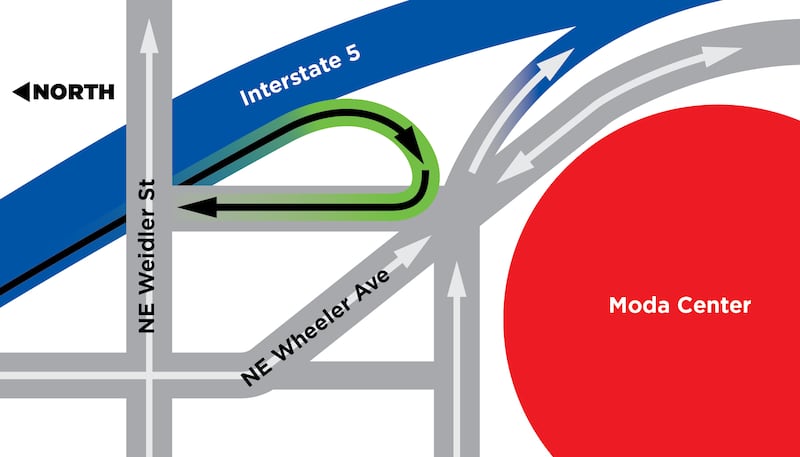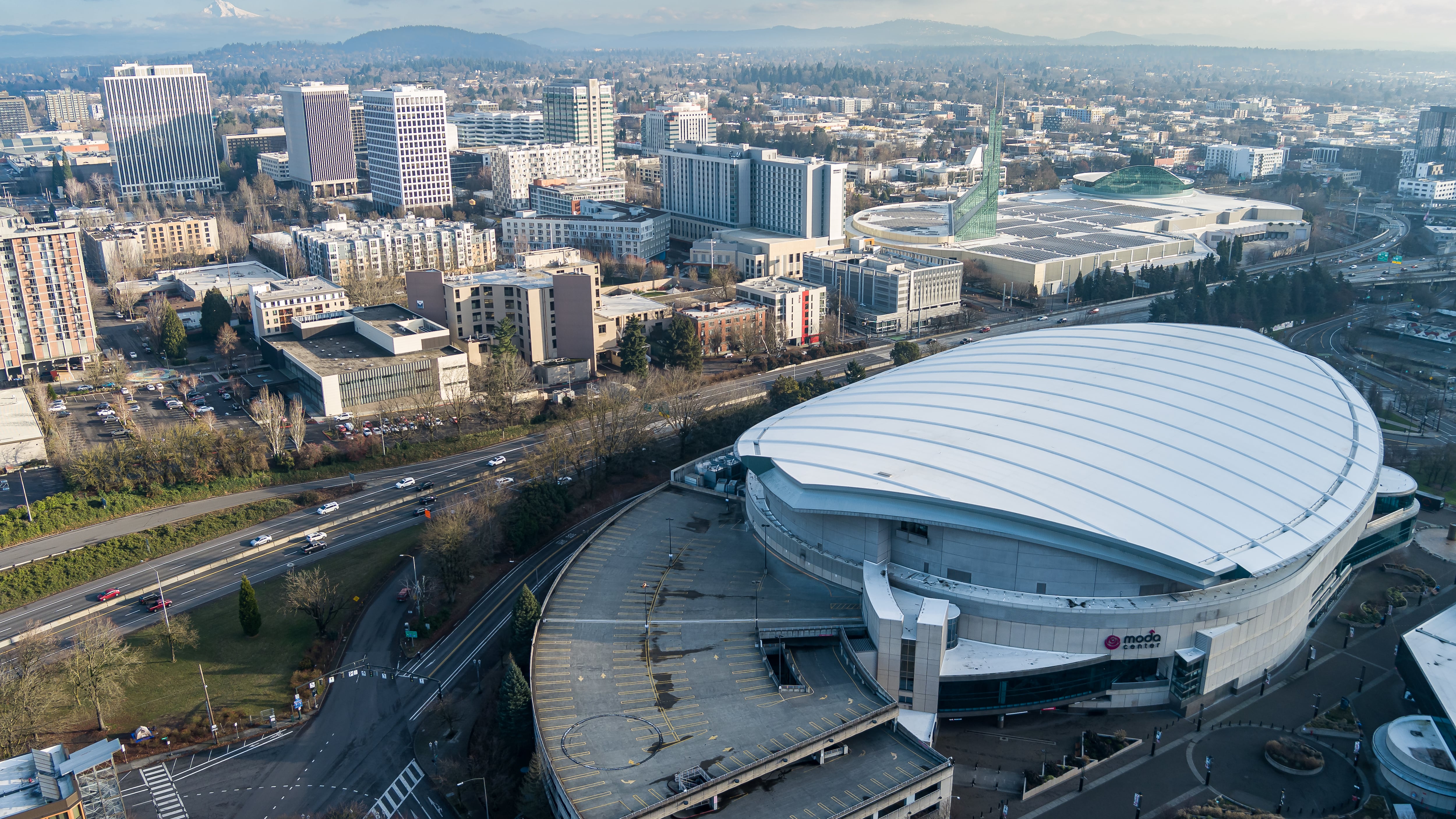The Oregon Department of Transportation is eager to move forward on the expansion of Interstate 5 at the Rose Quarter, but a powerful new critic has emerged.
That critic is a sleeping behemoth that rarely weighs in on public policy: Rip City Management, the corporate entity that operates Moda Center and Memorial Coliseum for the Portland Trail Blazers basketball team.
Rip City hosts 250 events a year, attracting 1.7 million spectators, half of whom arrived on foot or bicycle.
The organization says ODOT’s new design increases risks for those people.
“As the largest gathering place in the state, we needed to raise our hand about the safety and future in and around the Rose Quarter,” Chris Oxley, the Blazers’ director of government affairs, tells WW. “We all have the same goal here, and that is to see this area thrive. The current plan will make an already challenging situation worse.”
Both the the Blazers and Rip City Management are owned by the estate of late billionaire Paul Allen. And Rip City’s unhappiness with ODOT comes at a critical moment. In the wake of Allen’s 2018 death, future ownership of the Blazers remains uncertain and the team’s ground lease with the city of Portland is up for renewal. It’s unlikely the NBA would let the franchise leave Portland, but few want to take that risk.
The public comment period for the latest version of ODOT’s proposed $1.45 billion expansion closed Jan. 4. In a 20-page letter for the agency’s supplemental environmental assessment, Rip City detailed its concerns.
The organization’s biggest beef: the redesign of the southbound I-5 off-ramp. The new configuration would create a whiplashing 210-degree turn for exiting traffic and require four additional turns across already jam-packed intersections for traffic entering the Rose Quarter (see map).

That would make it more perilous for pedestrians and cyclists and trickier for motor traffic headed for Blazers games and other Rose Quarter events. By ODOT’s own admission, it would increase crashes in what city figures show is already one of Portland’s most dangerous traffic corridors.
ODOT’s goals for the project are to reduce congestion, help repair the Albina neighborhood, and decrease crashes. “This project must improve safety for pedestrians, cyclists, drivers and all travelers,” says Brendan Finn, director of ODOT’s Urban Mobility Office.
Rip City says that won’t happen.
“Unfortunately, ODOT is rushing through a [design] that transfers a safety and traffic problem from I-5 to the Rose Quarter,” the organization wrote in its public comments.
“The proposed design does not improve on transportation safety over existing conditions and, in fact, creates more potential for conflict and risk between all modes. The increases in conflicts and risk raises the potential for injuries and deaths.”
ODOT began working in earnest to expand I-5 at the Rose Quarter in 2017. The agency proposed adding capacity to the narrow, 1.8-mile section of freeway.
The department has faced resistance on a variety of fronts. Supporters of Harriet Tubman Middle School, adjacent to I-5, said the project would worsen air quality around the school. To eliminate that concern, lawmakers appropriated $120 million last year to relocate Tubman.
The Albina Vision Trust wanted ODOT to use the project to help repair Portland’s historically Black neighborhood, which was partially razed and bisected by the construction of I-5 in the 1960s.
Last year, the department produced a new design, called Hybrid Option 3 that includes a partial cap over the freeway. The agency hopes the cap will help knit Albina back together.
To make space for the freeway cap, however, ODOT redesigned the I-5 southbound off-ramp. It starts farther south, giving more room for the cap—but creates a sharper turn from the highway onto Northeast Williams Avenue.
ODOT’s written description of the design change is deceptively simple.
The I-5 southbound off-ramp would move south of Northeast Weidler Street at Wheeler Avenue by Moda Center, ODOT documents say. “This change improves the quality of developable land space on the highway cover and provides more space for people walking, biking and rolling through the area.”
After seeing the new design last year, Rip City Management hired GBD Architects of Portland to review it and retained the Schwabe, Williamson & Wyatt law firm.
“The schedule presented by ODOT provided no opportunity for meaningful input,” RCM explained in written comments.
Those comments include explicit criticism of the department’s work.
Rip City says ODOT’s analysis of the impacts of the design change includes “improper manipulation of traffic safety reports,” adding that the agency “had falsely portrayed crash data and used that as a basis for project construction.”
In a technical safety report ODOT released Aug. 15, the agency acknowledges the new ramp design doesn’t meet Highway Safety Manual standards and includes a “sharp curve” that would make “the forecast crash rate at this location… approximately 13% higher.”
Others share Rip City’s safety concerns. In a seven-page comment to ODOT, the Portland Bicycle Advisory Committee zeroed in on the same off-ramp.
“The southbound off-ramp to Williams is exceedingly unsafe for people walking and bicycling, probably the most dangerous spot for this infrastructure in the project area,” the group wrote in its Dec. 27 comments.
The Portland Pedestrian Advisory Committee agreed, writing in comments to ODOT, first reported last week by BikePortland, that the new design would “generally worsen conditions.”
Rip City’s analysis also suggests the freeway expansion would make it more difficult to get trucks in and out of the neighborhood—a critical matter since concerts and other events often require big rigs to move equipment in and out of the arenas.
More broadly, the Blazers organization fears, the current design would undermine development of the long-blighted Rose Quarter, an unrealized city goal.
“The I-5 project should attract high-density, mixed-use development to an area that has languished,” the organization wrote. “The proposed [design] exacerbates the unattractiveness to redevelopment at the Rose Quarter.”
That’s a blow to ODOT, which seemed to have placated all its major critics except for environmentalists, led by the group No More Freeways. (That group has sued to block the project, which it says would increase traffic and emissions, not reduce them.)
But the Trail Blazers enjoy a large, devoted following.
Pollster Adam Davis has tracked Portlanders’ views on the team since the late ‘70s. Davis says most area residents—not just fans who attend games—consider themselves Blazer fans.
“They are two to three times more likely to volunteer a positive association with the team,” Davis says. (By the Blazers’ own metrics, 825,000 adults in the metro area “watch, stream, attend, listen, or follow the Blazers.”)
ODOT says it will take the concerns raised by Rip City and others in the public comment period seriously.
“The highway cover design is in its early stages,” ODOT’s Finn says. “This portion of the federal approval process is designed to identify all impacts and get stakeholder feedback. The concerns being raised are an important piece of this process. We will evaluate those concerns with stakeholders and our partners at the city of Portland and develop solutions together.”
